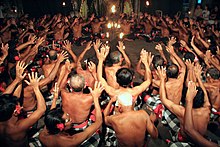Kecak

The Kecak , also Ketjak, Ketjack or Ketiak , is a Balinese dance drama in which 50 to 100 male dancers dressed in a black and white checkered loincloth perform antiphon in choir with a solo singer performing verses based on elements of the Indian epic based on Ramayana .
Sitting or standing, they form a circle and embody the mythological army of monkeys, the helpers of Prince Rama . With changing pace and volume they shout “Kecak Kecak Cak-a-Cak” while performing conjuring movements with arms and hands. Accompanied by singing, other figures join the circle of dancers such as Rama, his wife Sita , the ape general Hanuman , the eagle-shaped messenger of the gods Garuda and, as opponents, the demon king Ravana .
history
The Kecak has its roots in the old Balinese trance dance Sanghyang . The Kecak has only existed in its current form since around 1930. The idea for the Kecak originally came from the German painter Walter Spies . Today the kecak is a popular tourist attraction for Western (and Japanese) tourists, often combined with other dances. The rock temple of Ulu Watu and the Pura Dalem in Ubud are considered places to experience the Kecak in an extremely intense atmosphere. The Kecak music style and the instrumental ensembles with the jaw harp genggong, also introduced in the 1930s, do not correspond to traditional Balinese musical tastes.
Entrance to the modern age
A Kecak performance can be seen in Ron Fricke's film Baraka . Federico Fellini used the Kecak singing in his Satyricon . The same applies to the films of the Coen brothers , in which he served as the uncanny accompaniment to violent scenes.
The Japanese video game music composer Hiroki Kikuta used the rhythm of the Kecak for the song The Oracle in the video game Secret of Mana , which was released in 1993 for the SNES .
The group Mr. Bungle incorporated the singing of the Kecak dance into one of their songs and converted it into a kind of "hard rock" version. The part of the Balinese chant starts at about 2'40 minutes in the song Goodbye Sober Day .
The German electronic dance music formation RMB used the spoken chant of Kecak, which was recorded for a scene in the French erotic film Emmanuelle 2 - Garten der Liebe (1975), as a sample in the track Chakka Chakka on their album This World is Yours .
Kitaro used a Kecak recording in the track Magical Wave (album Dream , 1992), as did Mike Oldfield in the tracks The Wind Chimes ( Islands , 1987) and Bones ( To France 12 , 1984).
literature
- Kendra Stepputat: The Genesis of a Dance Genre. Walter Spies and the Kecak. (PDF; 554 kB) In: Volker Gottowik (Hrsg.): The ethnographers of the last paradise. Victor von Plessen and Walter Spies in Indonesia. Transcript, Bielefeld 2010, pp. 267-285
- Kendra Stepputat: Performing Kecak: A Balinese Dance Tradition Between Daily Routine and Creative Art. In: Yearbook for Traditional Music, Vol. 44, 2012, pp. 49-70
Web links
- Simon Tisdall: Primate scream: Bali's monkey dance. theguardian.com, April 13, 2011
Individual evidence
- ↑ Ernst Heins: Review: Toth, Andrew. Recordings of the Traditional Music of Bali and Lombok. Society for Ethnomusicology, Inc., Special Series No. 4, 1980. In: Yearbook for Traditional Music, Vol. 14, 1982, p. 136
- ^ Mark Slobin: Folk Music: A Very Short Introduction . Oxford University Press , New York City 2010, ISBN 978-0-19-975308-6 , pp. 115 ( limited preview in Google Book search).
